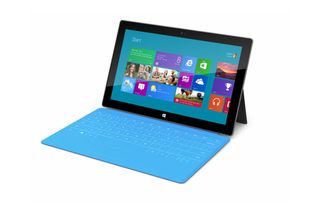Windows 8 Surface tablets - Need to Know
Microsoft has built-in a kickstand, offers a detachable Touch Cover and the choice of Intel Ivy Bridge and ARM-based processors.
In an attempt to offer business users a direct rival to the Apple iPad and MacBook Air, Microsoft will be releasing two Windows 8 tablets under the 'Surface' moniker.
The Windows RT and Windows 8 Pro models have been designed in-house by Microsoft. We take a look at the tablet/laptop hybrid to see what users can expect when they launch later this year.
Form factor
Surface tablets will have a hybrid form factor. When closed they will resemble an Ultrabook. However, they can be detached from the the keyboard and used as a standard tablet much like the Asus Transformer Prime.
The Windows 8 Pro device will come with a 10.6in ClearType Full HD (1,920 x 1,080) Gorilla Glass 2 display, making it almost an inch larger than the iPad (9.7in). Windows RT models will have the same 10.6in form factor, but will come with a slightly lower 1,366 x 768 resolution.

The Windows 8 Surface tablet has a flexible from factor so it can be used as a tablet or laptop
Microsoft has used VaporMg (pronounced Vapor-Mag) technology for the chassis, which the firm says mimics the feel of a luxury watch. The Windows 8 Pro device will weigh in at 903g and be 13.5mm thick. Meanwhile, the Windows RT edition will be the lighter (676g) and thinner (9.3mm) of the two devices.
Specifications
The Windows 8 Pro model will be powered by an Intel Ivy Bridge processor, giving the device a performance to rival an Ultrabook's. The chassis will have a built-in microSDXC slot, USB 3.0 port, mini DisplayPort connector, as well as 2x2 MIMO antennaes for wireless connectivity. Microsoft will offer a choice of 64GB or 128GB of internal storage.
Get the ITPro. daily newsletter
Receive our latest news, industry updates, featured resources and more. Sign up today to receive our FREE report on AI cyber crime & security - newly updated for 2024.
The Windows RT model will run on an ARM-based NVIDIA Tegra chip, with either 32GB or 64GB of storage available. Integrated features will include a microSD slot, micro HD connector, 2x2 MIMO antennae, but these devices will support USB 2.0 initially.
The specifications suggest the Windows 8 Pro tablet will go head-to-head with the MacBook Air range and the Windows RT device aims to provide an alternative to the iPad.
Integrated kickstand
Microsoft has added some nifty features to Surface. The integrated kickstand will allow the devices to be place on a desk without having to connect them to a keyboard. This will make it particularly useful to business users, as the tablet can be used alongside another device on a desk.

The kickstand allows the device to be placed on flat surfaces without the need for the dock




